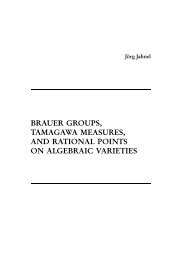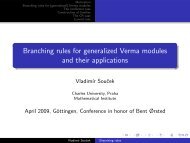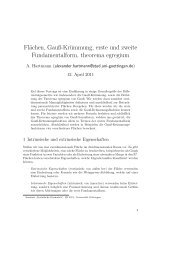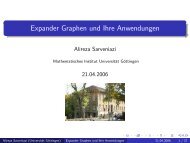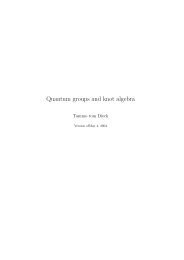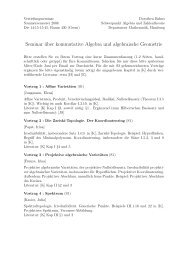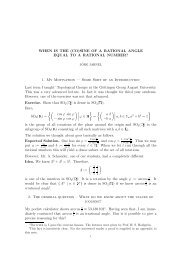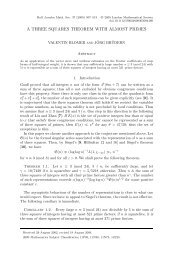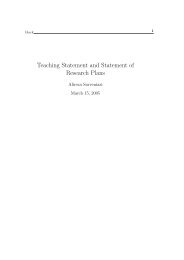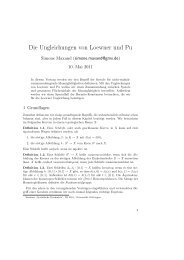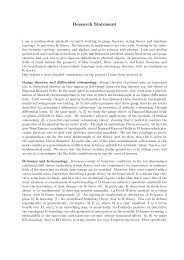Glanon groupoids - Mathematisches Institut - GWDG
Glanon groupoids - Mathematisches Institut - GWDG
Glanon groupoids - Mathematisches Institut - GWDG
You also want an ePaper? Increase the reach of your titles
YUMPU automatically turns print PDFs into web optimized ePapers that Google loves.
The following are two standard examples [16].<br />
Examples 2.5. (a) Let J be an almost complex structure on M. Then<br />
( )<br />
J 0<br />
J =<br />
0 −J ∗<br />
(b)<br />
is 〈· , ·〉 M -orthogonal and satisfies J 2 = − Id. J is a generalized complex structure<br />
if and only if J is integrable.<br />
Let ω be a nondegenerate 2-form on M. Then<br />
⎛ (<br />
J = ⎝ 0 − ω ♭) ⎞<br />
−1<br />
⎠<br />
ω ♭ 0<br />
is a generalized complex structure if and only if dω = 0, i.e., ω is a symplectic<br />
2-form.<br />
2.3. Pontryagin bundle over a Lie groupoid.<br />
The tangent prolongation of a Lie groupoid. Let Γ⇒M be a Lie groupoid. Applying<br />
the tangent functor to each of the maps defining Γ yields a Lie groupoid structure on T Γ<br />
with base T M, source T s, target T t and multiplication T m : T (Γ × M Γ) → T Γ. The<br />
identity at v p ∈ T p M is 1 vp = T p ɛv p . This defines the tangent prolongation T Γ⇒T M of<br />
Γ⇒M or the tangent groupoid associated to Γ⇒M.<br />
The cotangent Lie groupoid defined by a Lie groupoid. If Γ⇒M is a Lie groupoid<br />
with Lie algebroid AΓ → M, then there is also an induced Lie groupoid structure on<br />
T ∗ Γ⇒ A ∗ Γ = (T M) ◦ . The source map ŝ : T ∗ Γ → A ∗ is given by<br />
ŝ(α g ) ∈ A ∗ s(g) for α g ∈ T ∗ g Γ,<br />
ŝ(α g )(a(s(g))) = α g (a l (g))<br />
for all a ∈ Γ(A), and the target map ˆt : T ∗ Γ → A ∗ is given by<br />
ˆt(α g ) ∈ A ∗ t(g) ,<br />
ˆt(α g )(a(t(g))) = α g (a r (g))<br />
for all a ∈ Γ(A). If ŝ(α g ) = ˆt(α h ), then the product α g ⋆ α h is defined by<br />
(α g ⋆ α h )(v g ⋆ v h ) = α g (v g ) + α h (v h )<br />
for all composable pairs (v g , v h ) ∈ T (g,h) (Γ × M Γ).<br />
This Lie groupoid structure was introduced in [8] and is explained for instance in [8, 32, 27].<br />
Note that the original definition was the following: let Λ Γ be the graph of the partial<br />
multiplication m in Γ, i.e.,<br />
Λ Γ = {(g, h, g ⋆ h) | g, h ∈ Γ, s(g) = t(h)}.<br />
The isomorphism ψ : (T ∗ Γ) 3 → (T ∗ Γ) 3 , ψ(α, β, γ) = (α, β, −γ) sends the conormal space<br />
(T Λ G ) ◦ ⊆ (T ∗ Γ) 3 | ΛΓ to a submanifold Λ ∗ of (T ∗ Γ) 3 . It is shown in [8] that Λ ∗ is the graph<br />
of a groupoid multiplication on T ∗ Γ, which is exactly the multiplication defined above.<br />
The “Pontryagin groupoid” of a Lie groupoid. If Γ⇒M is a Lie groupoid with Lie<br />
algebroid A → M, according to [30], there is hence an induced VB-Lie groupoid structure<br />
on P Γ = T Γ ⊕ T ∗ Γ over T M ⊕ A ∗ , namely, the product groupoid, where T Γ ⊕ T ∗ Γ and<br />
T M ⊕ A ∗ are identified with the fiber products T Γ × Γ T ∗ Γ and T M × M A ∗ , respectively.<br />
It is called a Courant groupoid by Mehta [30].<br />
Proposition 2.6. Let Γ⇒M be a Lie groupoid with Lie algebroid A → M. Then the<br />
Poytryagin bundle P Γ = T Γ ⊕ T ∗ Γ is a Lie groupoid over T M ⊕ A ∗ , and the canonical<br />
projection P Γ → Γ is a Lie groupoid morphism.<br />
6



